Gaining a new customer requires a substantial investment in time and money, and recreating a satisfying client experience is similarly tricky.
Instead of repeating the same process for each new client, why not use your current customer base for marketing your brand?
Referral marketing comes into play here.
By encouraging existing customers to engage in word-of-mouth marketing, referrals help you spread the word about your brand.
If you’re uncertain about how to develop a sophisticated referral program to accelerate your sales, you’ve come to the perfect place.
We’re discussing:
That said, let’s get right into it!
A referral program is a word-of-mouth marketing strategy that compensates existing customers for recommending your business to their family, acquaintances, friends, and coworkers.
Also, a referral program offers existing customers a reward such as a gift card, a discount, shop credit, free items, or swag in return for bringing in new clients.
The benefit of a customer referral program (or refer-a-friend program) is that it allows business owners to quickly identify and monitor their most devoted brand advocates and the sources of their new consumers.
Furthermore, a formalized program makes it simple for customers to spread the word about your company by providing a referral page and personalized messages.
They don’t simply share with anyone; they recommend leads who are a good match for your company and are more likely to order from you.
Hence, referral programs mean satisfied clients and transform them into dependable advocates.
When you pick a one-sided reward for your referral campaign, either the referrer or the referred will receive a reward for their participation, but not both parties.
A two-sided referral program rewards both parties for a successful recommendation; the advocate receives the referral offer, while the new customer gets the friend offer.
Any referral program begins with an advocacy approach.
Your brand advocate (could be a consumer, industry expert, etc.) shares a positive referral or offer with their friends or related audience.
The receiver then explores the brand through an offer link or is directed to the company’s landing website.
Ideally, the recommended consumer will claim an offer or make the first purchase at this time.
Ultimately, they become the next generation of brand ambassadors and share their good recommendations with their friends or distinct audiences.
In addition, performance marketing is becoming an increasingly common means of implementing referral marketing strategies in the present day.
Performance marketing (often referred to as partner marketing or affiliate marketing) is a method whereby businesses compensate affiliate partners for each sale they create.
Therefore, affiliates are motivated to market a brand’s products and services to their target audiences.
In exchange for their marketing efforts, brands receive a ready-made audience, and affiliates receive cash compensation for their efforts.
A referral program is one of the most successful strategies to increase the number of consumers who progress through the sales funnel.
According to McKinsey & Company, a consumer is substantially more likely to purchase a product after hearing about it from a family member than from a complete stranger.
Additionally, advocates of a brand are 50% more likely to influence a purchase, as mentioned by Marketing Charts.
Consumers are, not surprisingly, more likely to trust their networks than sponsored advertisements.
The power of word-of-mouth can speed up your customer acquisition process.
For this reason, it’s crucial for firms to implement a referral program and reward current consumers for promoting their company throughout their network.
We’ve compiled the most significant advantages that a referral program will provide for you right below:
Customers that have had a good experience with your brand are inclined to continue doing business with you.
Referral programs allow businesses to discover and monitor their most loyal and happy customers.
According to research by Accenture, 91% of respondents indicated that they are most inclined to buy from firms that provide relevant recommendations and offers.
One reason organizations prefer referral marketing is that it provides greater brand confidence.
Referrals from friends, family, coworkers, and other reputable organizations and industry influencers instill products and services with credibility and confidence.
Despite the global expansion of influencer marketing, customers continue to place the most faith in recommendations from friends and family.
Consider it this way: Imagine you want to buy a new electronic device like a smart TV, for instance.
There are hundreds of identical items on the market, each claiming to offer the most remarkable features and characteristics.
A reference from a trustworthy friend or influencer who has tried, evaluated, and recommended a specific smart TV is likely to assist you in making your final selection, correct?
This endorsement has made the company safer, more reputable, and more deserving of your hard-earned money.
Before purchasing a product, consumers seek feedback from their social network to decide whether the investment is worthwhile.
According to McKinsey & Company, 41% of consumers comment on and interact with companies to gain feedback and information that would assist them in evaluating their purchase choice.
Additionally, word-of-mouth is an essential sales touchpoint, particularly in the telecommunications industry, where 47% of transactions were significantly affected by brand mentions.
Referrals can occur naturally through in-person discussions or social media posts praising your company, but they aren’t always practical.
Moreover, providing clients with referral program incentives (such as discounts, promotions, and exclusive items) can encourage them to recommend additional individuals within their network.
According to a 2022 survey by ThinkImpact, 83% of satisfied consumers are willing to refer a firm after making a purchase.
Additionally, 78% of recommendations result in qualified consumer leads for the business.
It’s now time to launch a successful referral program, but not before doing some groundwork to ensure that it functions well and, more importantly, offers a positive customer experience and customer lifetime value.
The first stage is to establish successful marketing goals.
What are the objectives of your referral marketing campaign?
The typical referral program objectives are:
Nonetheless, it’s worthwhile to investigate what can be accomplished and how broad goals can be achieved on a smaller scale.
You may want to boost the number of sign-ups within a specific consumer category.
For example, you might attempt to offer a particular product to individuals who have been referred to it.
Furthermore, several possible objectives might be set; establishing them from the beginning, considering them, and evaluating them as the campaign advances are essential.
There is no cause for concern regarding the addition or modification of future objectives.
You will be successful if you don’t change the goalposts to make them more accessible.
There are two standard options for determining who receives the prize: a one-sided incentive and a two-sided incentive.
The success of referral marketing activities increases depending on the number of awards and incentives offered.
Just one individual will receive a referral reward, which might be the referrer or the referred individual.
An example of referral marketing is when a current customer provides a new client with 500 account credits.
This is similar to affiliate marketing, but the emphasis is on the individual’s network instead of established public audiences.
The most common kind of referral marketing is two-sided incentives, in which both parties receive a benefit.
It’s all about crediting the referrer and offering the first purchase for free to those referred.
Nearly all referral program templates are similar in several aspects.
The images, messaging, and incentives may vary, but the objective is to establish a terrific referral program for their clientele.
Learn how to target the appropriate audience since different companies and entrepreneurs attract different types of clients.
Therefore, you should conduct several surveys and study the data to understand their needs.
Once you have determined their requirements, you can design a great referral program template.
Remember that using software to create your referral program is always more accessible and efficient.
Here at Viral Loops, we provide various templates to meet any of your different needs and approaches.
For instance, the “Refer a Friend” template can make your referral life easier as it’s an all-time classic with many widgets.
You’ll have all the help you need as the widget looks great on all platforms, whether it’s on a PC, a tablet, or a smartphone.
It also has a fraud detection system that keeps all identity threats out of your way.
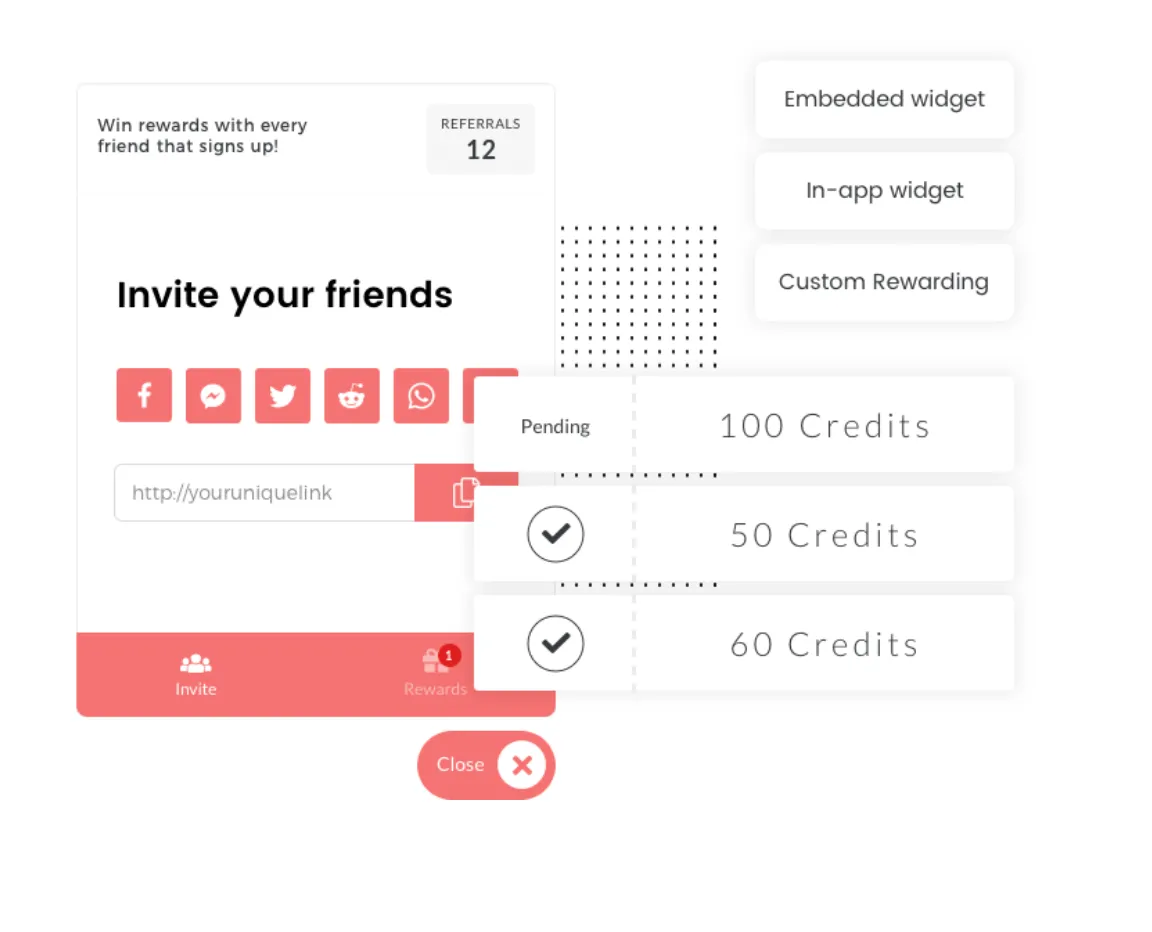
People must comprehend the program’s purpose and specific benefits (rewards). Otherwise, the program’s objective won’t be met.
Your headline attracts customers and explains why they should stay.
Hence, customers shouldn’t read long texts; they want to know quickly what you’re all about.
Include your headline in the subject line or first line of your invitation to prevent recipients from clicking away or disregarding your communication.
In addition, consider the invitation to your referral program as a job description for potential recruits.
What information must they have about the program?
How can available jobs for referral program advocates be filled?
Fill in the blanks, but don’t go overboard; just stay clear and brief.
Furthermore, include an easy-to-find call to action at the end of your message, such as an eye-catching button with a direct link to the referral program page.
This will get your advocate to their destination without any interruption or delay.
Referral software simplifies and streamlines the management of campaigns.
You’ll be able to track the success of your whole marketing channels and individual participants and optimize your business growth strategies.
Keeping track of successful referrals and marketing tactics, receiving rewards, and manually creating referral links may be time-consuming.
Yet, well-structured referral program software automates all of these processes.
Popular referral software features include:
After evaluating the new rewards program, it’s time to promote it to your most loyal consumers.
We’ve compiled a list of five effective techniques to market your referral program and make it go viral:
Also, you may automate the email flow by sending it on the invoice a few weeks after the purchase, when the customer has had ample time to utilize the product.
Referral programs aren’t one size fits all.
You can always gain a lot from implementing a different program or two.
Referral competitions and contests often incentivize participants if they reach a certain threshold of referrals.
You can also give a bonus to the customer of the month who referred the most individuals throughout the contest.
A contest is an excellent way to get new leads since it encourages consumers to invite as many friends as possible through their referral links.
In addition to instilling a sense of urgency, the contest’s tight time limit imposes a feeling of urgency.
A referral program approach that involves a business presenting its existing and newly recommended consumers with credit, cash, or discounted items is unlikely to disappear.
The optimal method for doing this is to match the incentives for both consumers.
A simple reward, such as a $5-$10 discount for both consumers, is typically sufficient to convince them to join your referral program.
It’s pretty straightforward: a referring client recommends your business to a buddy.
In exchange, consumers receive an enticing incentive such as shop credit, a cash card, or a discount on their subsequent purchases.
In addition, the newly gained consumer also receives a comparable incentive, compensating them for conducting business with your company.
This referral program offers customers discounts for each recommendation they receive.
For instance, a consumer receives a 10% discount on their gym membership if they recommend a friend, with the discount increasing as more individuals get referred.
Therefore, by referring 10 new customers, the consumer won’t have to pay for their membership.
We recommend creating a rule stipulating that rewards are only applicable if both the referring and referred customers are active to ensure that both you and your customers receive benefits.
This helps maintain cash flow and boosts client satisfaction and customer loyalty.
The variety of events and holidays throughout the year is maybe the most exemplary aspect of having seasonal referral campaigns.
Whether it’s more classic holidays like Christmas or New Year’s, celebrations earlier in the year like Valentine’s Day or St. Patrick’s Day, or even more out-of-the-ordinary occasions like World Environment Day or World Peace Day, you have an abundance of options.
Also, whatever opportunity or event you choose, ensure that the main reward at the end of the campaign is sufficiently enticing to participants.
Your participants can feel easily deterred by a prize they deem unworthy of submitting an entry.
To ensure the success of this sort of referral campaign, it is essential to give a type of reward that embodies the spirit of a holiday or event.
A loyalty program transforms your referral program into a game to attract numerous recommendations.
Existing customers get points for sending referrals, which may be redeemed for tangible prizes, such as a free service, a free product, or a bundle of services.
For instance, a client can receive 10 loyalty points for each successful recommendation.
Consider the significance of your brand to your customers.
Whether your company supports anything of value? Does it help the local community?
Make use of it.
Motivate your clientele to keep your business and cause by associating each referral with a tangible incentive.
Social media is an excellent tool for spreading awareness about a noble cause.
Hence, seize this opportunity and spread the word that your customer referral program is prepared to assist anything or anyone in need.
Of course, ROI (Return on Investment) is vital, but you should also monitor the performance metrics of your social media postings.
Yet, people who don’t participate in your customer referral program are nonetheless exposed to your brand and, perhaps most importantly, see it favorably due to your brand-new social reason.
Rewarding loyal consumers with product or service enhancements is an excellent way to strengthen their loyalty to your company.
Suppose, for instance; your company provides SaaS services (software as a service).
Through your refer-a-friend program, customers could receive an upgrade to a premium package or free restricted access to extra features for successful types of referrals.
These rewards don’t cost your business anything, yet they are highly successful in acquiring new consumers.
Rewards also help with customer retention, which is a great bonus.
There are several excellent client referral program examples from which to take inspiration.
Regardless of your business or if you represent a global company or a startup, we have a referral example to showcase for you.
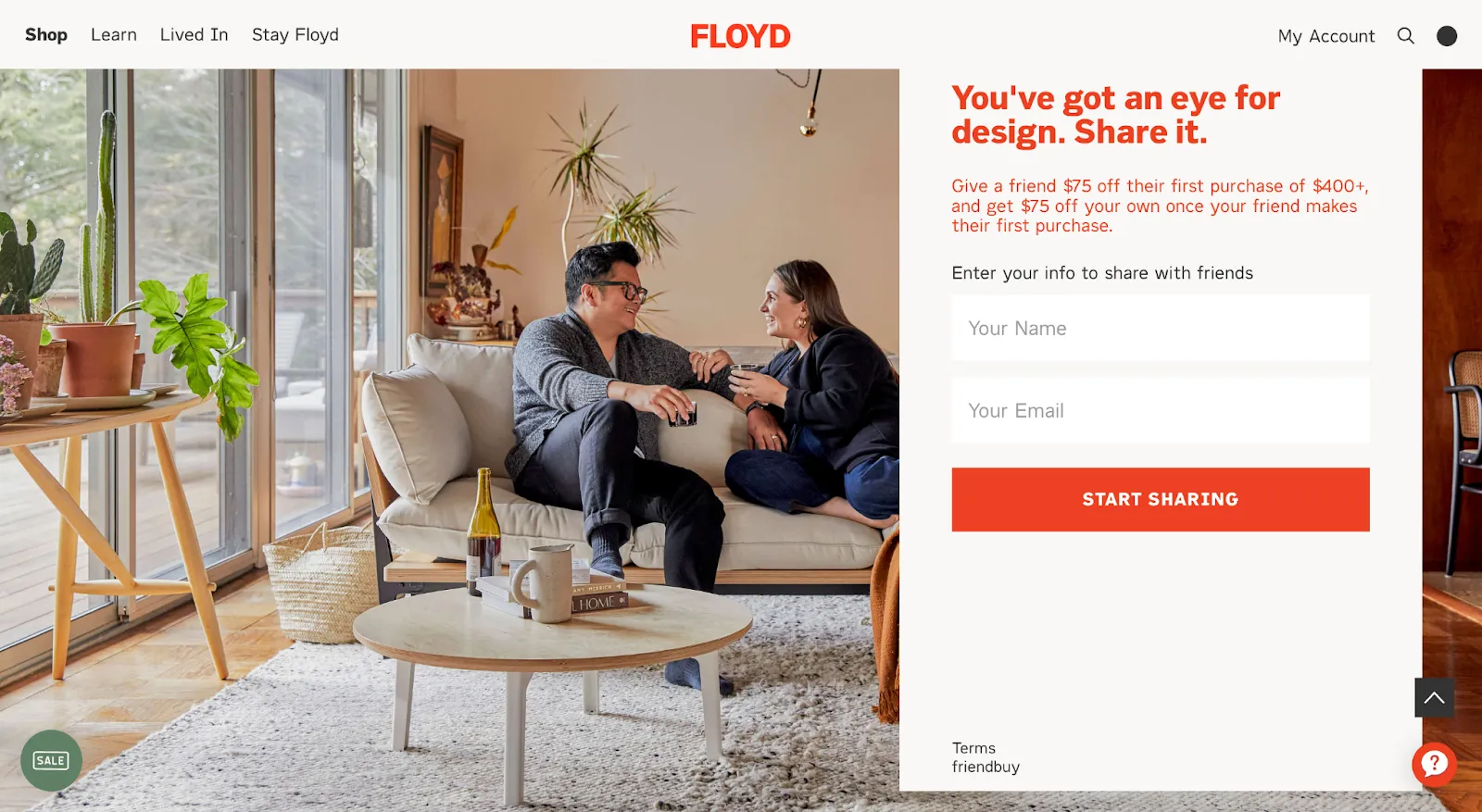
Image Source: Floyd
Floyd is a sustainable furniture firm that manufactures long-lasting furnishings “designed for longevity.” Its purpose is to make shopping for functional and flexible furniture easier.
Floyd provides consumers with a link to share with their friends, redeemable for $75 off orders of $400 or more; the consumer receives an identical discount.
Furthermore, Floyd’s approach utilizes this psychological factor since the ordinary customer must make a significant payment to purchase luxury furniture.
Additionally, Floyd’s referral strategy incentivizes customers to purchase high-quality designer furniture at a substantial discount.
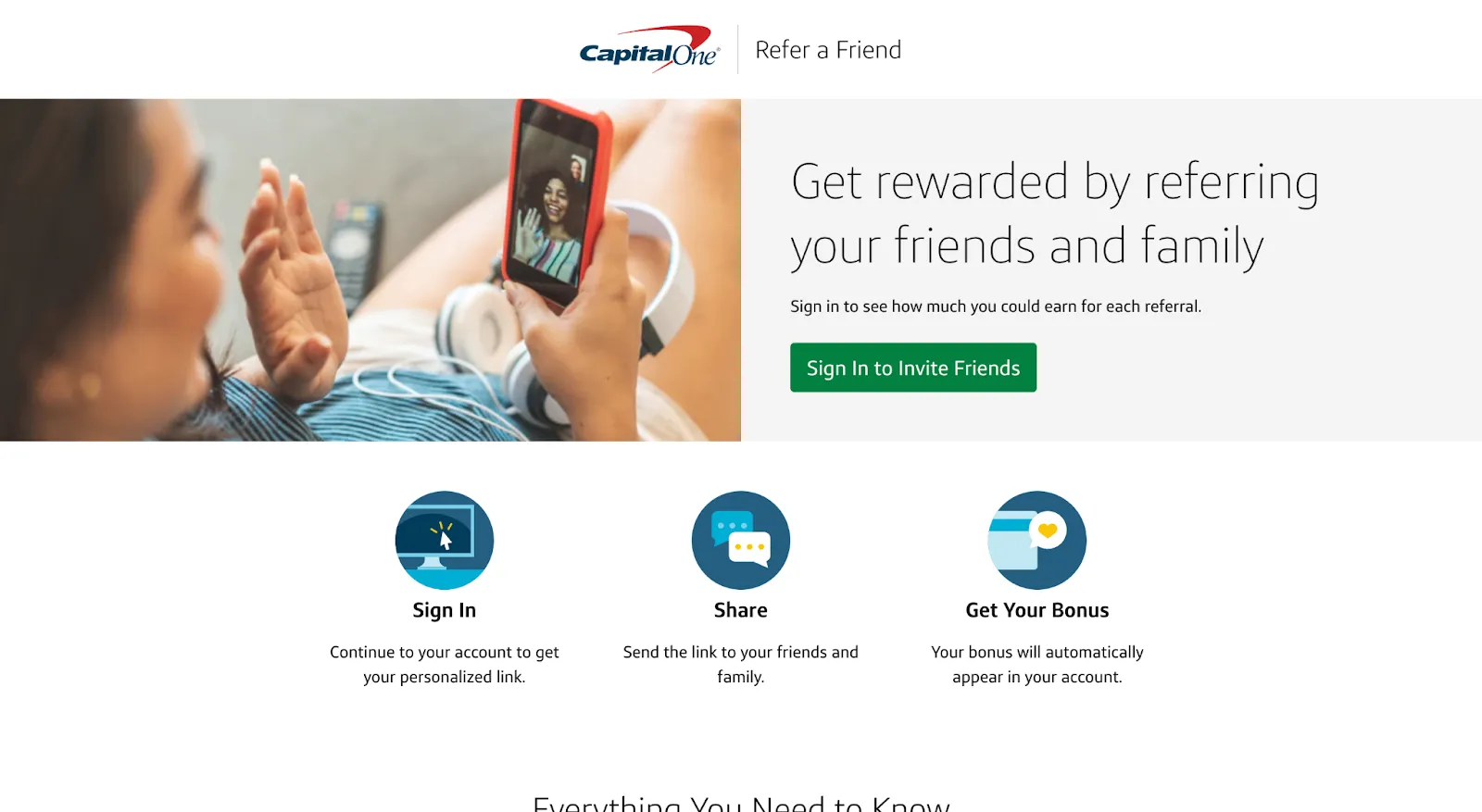
Image Source: Capital One
In addition to offering some of the most popular credit cards in the United States, Capital One has an excellent customer support department.
They use the “refer a friend” model to apply for a Capital One credit card and earn different rewards such as cash or points.
Customers receive benefits such as airline miles, cash back, and retail points depending on their card type.
Therefore, this encourages users to use their Capital One credit card rather than one issued by a competitor.
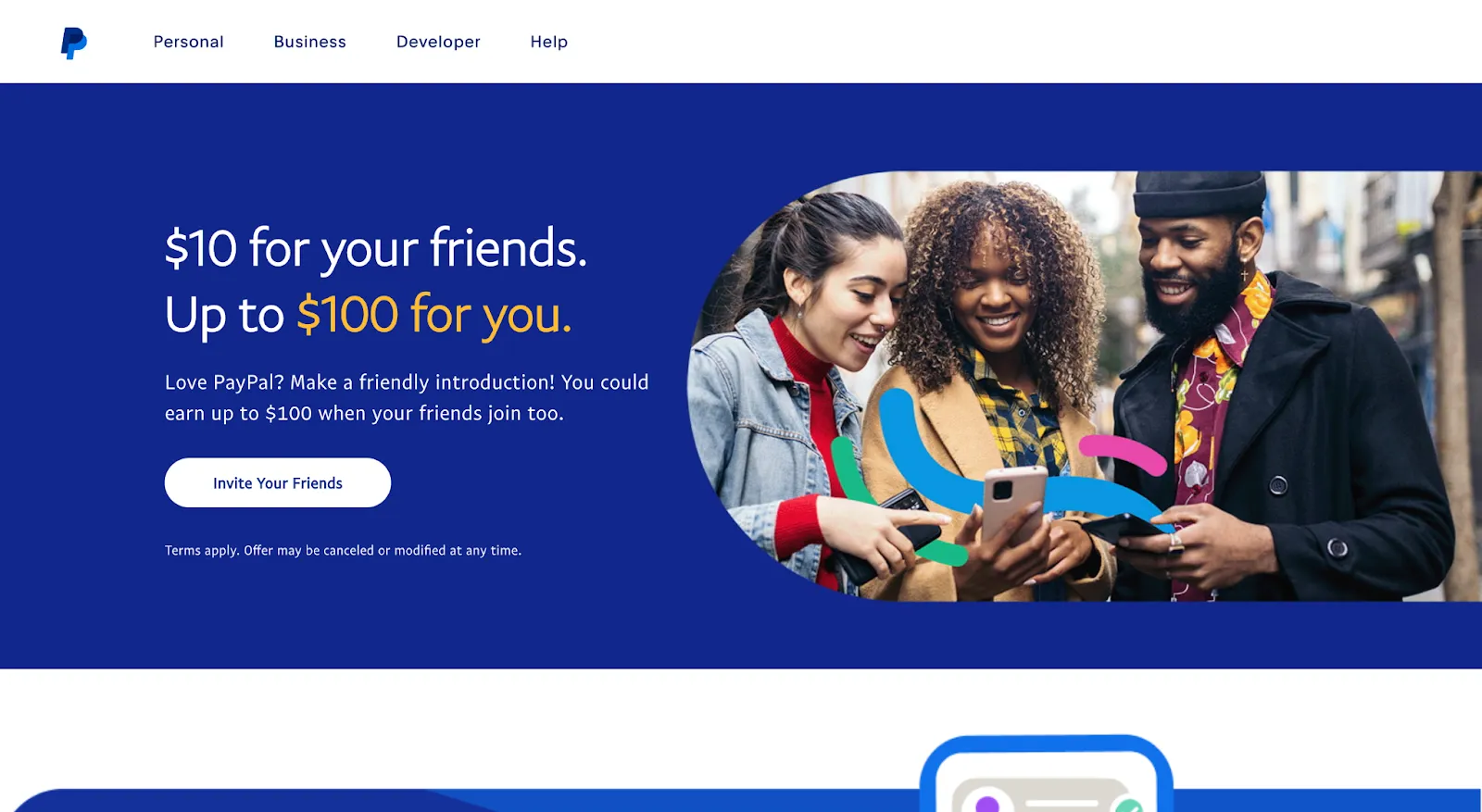
Image Source: PayPal
Before Dropbox created a success story based on its referral program, Paypal did so and encouraged Dropbox to build a program that incentivizes consumers to utilize the platform.
Paypal did it their own way; they gave out money for nothing.
Yet, it turned out to be a success!
The company’s Refer-A-Friend program increased daily sign-ups by 7 to 10%, surpassing 100 million users in less than two years.
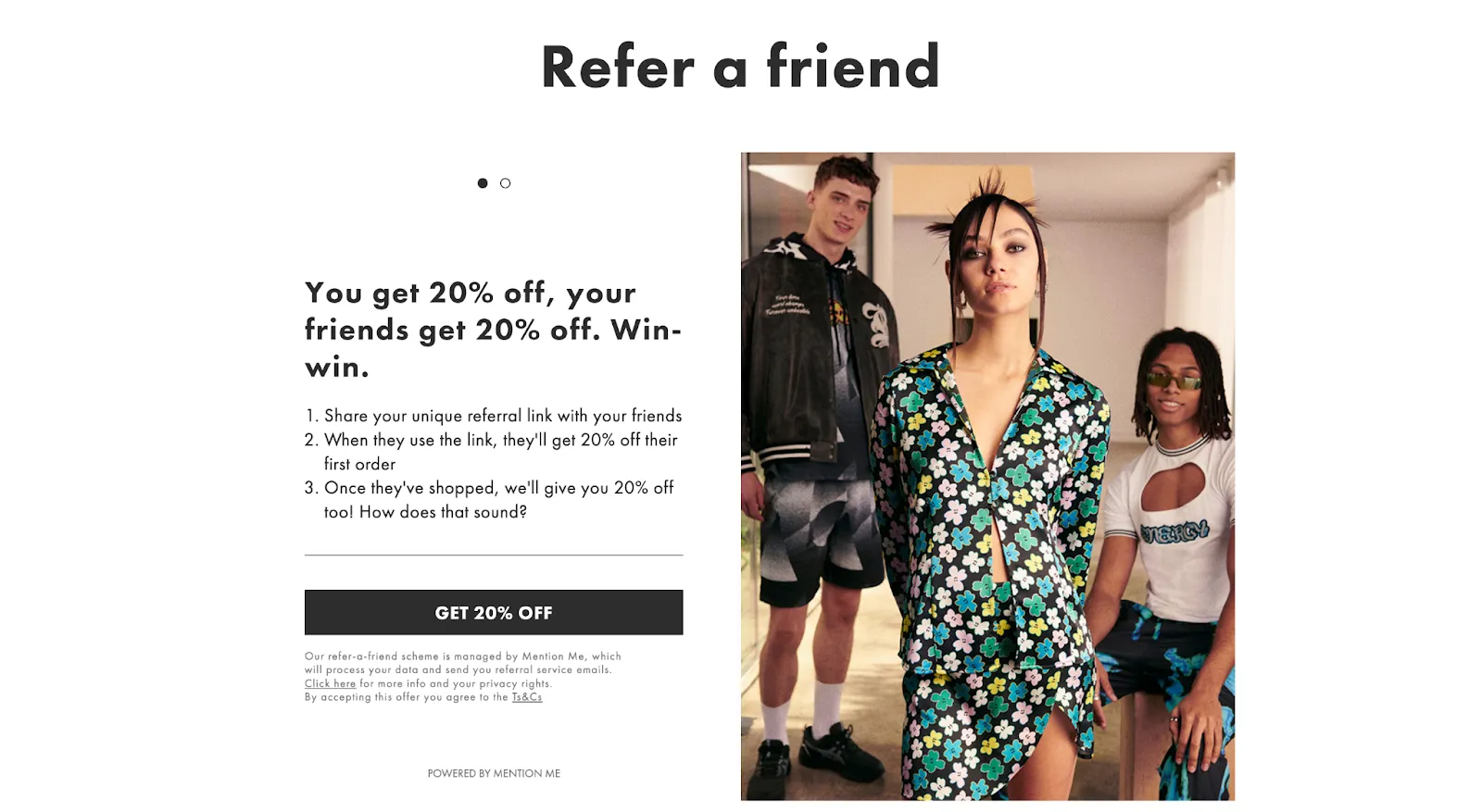
Image Source: ASOS
ASOS is an apparel business well-known for its innovative digital marketing efforts and active social media presence.
They have a cult-like following of clients who purchase from them at every opportunity, especially when there are discounts and post-purchase rewards.
ASOS capitalizes on this possibility by offering a two-sided referral form of marketing that grants a 20% discount to both the referrer (current customer) and the referee (new customer or referred friend).
Hence, ASOS’s customer referral template seems to be a win-win situation for everyone onboard.
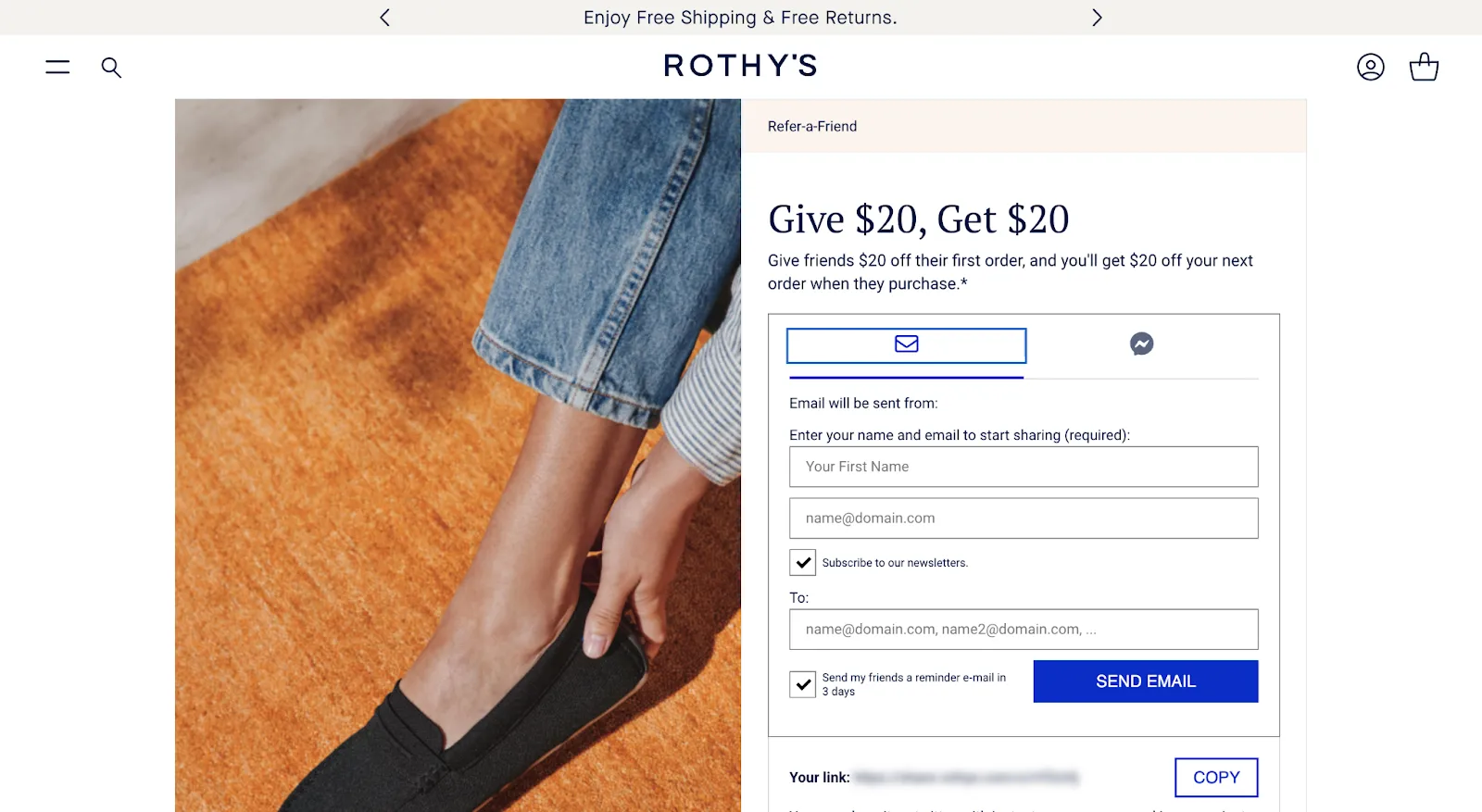
Image Source: Rothy’s
Rothy’s creates fashionable flats, shoes, and purses from 100% recycled plastic, and customers like them.
Regarding acquiring clients, word-of-mouth exceeds most of the brand’s marketing platform and referral marketing programs.
They have a Facebook group with over 23,000 customers who generate significant brand awareness.
Furthermore, Rothy’s cultivates this community via a referral process that directly caters to the collective interests of its customers/followers to expand its brand and acquire potential customers.
They also provide a direct discount of $20 and tiered rewards to their clients and any number of referrals they make.
Referral marketing is among the most cost-effective ways of acquiring new consumers because it benefits from the trust you’ve already established with your existing clientele.
There is no better way to develop your business sustainably than by implementing a strategy to encourage word-of-mouth marketing.
As with other business endeavors, preparation and strategy will ultimately pay off 🙂.
If you need help with your next big step, don’t hesitate to schedule a live demo with the Viral Loops team.